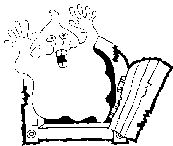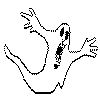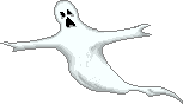
This is a copy of the handout I passed out at the ghost hunting presentation I gave at Newark's Emerson Miller Library on July 1, 2003.
What is a Ghost?
Basic Ghost Hunting Tips
Tips for Photographing Ghosts
Recording Ghostly Sounds
A Few Recommended Ghost Related Books and Websites
**************************************
What is a Ghost?
No one is 100% sure what a ghost really is, if they really exist. However, most people believe that a ghost is the spiritual remains of a person who refuses to cross over after death. The most important thing to remember is that ghosts are NOT evil!

In real life, ghosts do not look like the picture above...in fact, sometimes you canít see them at all!! So how do you know if thereís a ghost around? Here are a few common signs of ghostly activity:
- Unusual cold spots
- Unusual drafty/windy areas
- Unusual smells
- Strange sounds (voices, footsteps, moaning, crying, banging, etc)
- Anywhere that you get a strange "being watched" feeling
Ghosts often show up as strange lines or orbs on photos. They rarely show up as human or animal shapes.

- NEVER go alone!!!!!! A lot of common haunted places include cemeteries and old buildings which are well off the beaten path. You need at least one other person with you so you donít get lost, and also so you have someone there to help in case you get injured. Itís also a good idea to carry a first aid kit.
- Never go into an abandoned building without permission from the buildingís owner. If you enter an abandoned building without permission it is considered trespassing and you could go to jail!
- Use a 35mm camera with 400 speed film and/or a digital camera to take photos of ghosts (and other interesting things you might find!).
- Use a cassette recorder, a microcassette recorder, or a digital recorder to record ghostly sounds.
- Donít litter or take anything from the place youíre exploring!
- Most important tip: HAVE AN OPEN MIND AND HAVE FUN!
There are several places you can find ghosts:
- Cemeteries
- Historical places/museums
- Houses
- Churches
- Hospitals
- Parks
- Your own backyard!
You can learn about well-known haunted places by reading books or visiting websites about the city/state you live in.

- Donít take photos during rain or snow storms - rain drops or snowflakes may get on the camera lens and look like orbs!
- Make sure your camera lens is clean - fingerprints or dust may also look like orbs.
If the same ghostly image shows up in the same spot on all of your photos, chances are it is dust on the lens rather than a ghost. - Keep your fingers away from the camera lens when taking photos, a finger in the corner of a photo often looks like a ghost!
- Tie back hair, a loose hair in front of the lens is often mistaken for a ghost too.
- Donít smoke on investigations. Smoke may also show up in the photos and discredit any ghostly images. Also, smoking can be a fire hazard in cemeteries or old buildings.
- Avoid photographing glass or mirrors - they cause too much reflection, especially when the cameraís flash is used.
- Avoid taking photos of direct sunlight, this causes lens flare.
- Take photos in areas where you get a strange feeling or experience any ghostly activity (when you feel cold spots or smell any strange smells, etc).
- Use your flash at night - or if your camera has a night vision option use that instead.
- Take multiple photos of the same area - the more photos you take, the more likely it is that you will capture a ghost on film!
- Ask the ghostsí permission to take their picture - several people think this is the key to successful ghost photos!

Ask the ghost(s) questions. You probably wonít hear the answer to your question until you play the tape back, so pause before asking the next question.
Here are some tips for recording EVP:
- Use either a cassette recorder, microcassette recorder, or digital recorder.
- Use the highest possible recording level to get the best results.
- Some people recommend using an external microphone. This helps reduce sound caused by the tape when using either a cassette or microcassette recorder.
- At the beginning of the recording, state the date, time, and location youíre at. This is very important if you have multiple tapes of recordings, it will keep you from getting the tapes confused!
- Ask the ghost simple questions.
- Ask one question at a time.
- Donít talk or whisper when youíre trying to record an answer - your voice may cover up the EVP!
- Use headphones when listening to the recording. Some EVPs are very faint, and wearing headphones helps you hear the faint sounds better.

- The Ghost Hunter's Guide to Haunted Ohio by Chris Woodyard
- Haunted Ohio I-IV by Chris Woodyard
- Columbus Ghosts: Historical Haunts of Ohio's Capital by Robin Smith
- Ghost Stories of Ohio by Edrick Thay
- Ghosts: Ohio's Haunted Landscapes, Lost Arts, and Forgotten Places by Randy McNutt
- Ghosts of Marietta by Connie Cartmell
- Uneasy Spirits: 13 Ghosts of Clermont County by Rick Crawford
- Ghosts, Spirits, and Legends of Southeastern Ohio by Lawrence Everett
- Haunted Houses: Spooky Tales of Yellow Springs by Harold Igo
- Scary Stories to Tell in the Dark by Alvin Schwartz
- More Scary Stories to Tell in the Dark by Alvin Schwartz
- Scary Stories 3 : More Tales to Chill Your Bones by Alvin Schwartz
- In a Dark, Dark Room and Other Scary Stories by Alvin Schwartz
Websites:
- Grave Addiction (my site) - http://www.graveaddiction.com
- Forgotten Ohio - http://www.forgottenoh.com
- Ohio Exploration Society - http://www.ohioexploration.com
- Ohio Lost - http://www.geocities.com/ohio_lost/main.html
- Shadowseekers - http://www.shadowseekers.org
- Ghosts of Ohio - http://www.ghostsofohio.org
- Ghosts of the Valley - http://www.ghostsofthevalley.com
- Lost Southeast Ohio - http://www.angelfire.com/oh5/lost/
- Dead Ohio - http://www.deadohio.com
- Columbus Underground - http://www.geocities.com/columbus_underground
- Illicit Ohio - http://www.geocities.com/illicitohio
Where do you want to go? Select your destination: